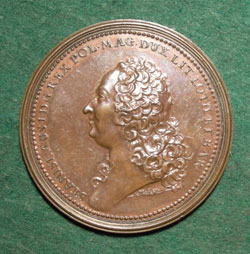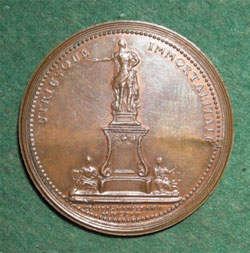

|
STANISLAUS I, KING OF POLAND: INAUGURATION OF THE STATUE
OF LOUIS XV |
|
|
ST. URBAIN, Marie Anna de: Lorraine, 1755, Bronze, 51 mm Stanislaus I (Leszczynski) (1677-1766), King of Poland (1704-1709, 1733-1736) and Duke of Lorraine and Bar (1737-1766) was the son of Rafael Leszczynski and Anne Catherine Jablonowska. He married Catherine Opalinska by whom he had one daughter, Mary. In 1704 Stanislaus, by bribery and intimidation and with the support of Charles XII of Sweden, became king of Poland, replacing Augustus II. However, he was later forced to relinquish the throne back to Augustus after the Swedish defeat at the Battle of Poltava. In 1725, Louis XV of France married Stanislaus’ daughter Mary and supported his claims to the Polish throne. With this support, after the death of Augustus II in 1733, Stanislaus regained the throne. This led to the war of the Polish Succession. In 1736 Stanislaus again abdicated the throne to Augustus III, who was aided by Russia. By way of compensation Stanislaus received the dukedom of Lorraine and Bar. In 1737, while Duke of Lorraine, Stanislaus planned to create a square intended to honor and glorify his son-in-law Louis XV of France. A bronze statue of Louis XV, in the uniform of a roman general, the work of two sculptors Guibal and Cyfflé, decorated the center of the square. The statue along with surrounding allegorical figures disappeared during the French Revolution, and in 1851 a new statue, this time of Stanislaus, was erected in its place. This medal commemorates the inauguration of the statue of Louis XV, in the Place Royal in the city of Nancy, which took place in 1755. The medal is by Marie Anna de St Urbain, the daughter of the eminent French medallist Ferdinand de St Urbain. She is one of the very few woman medallists of the period. |
|